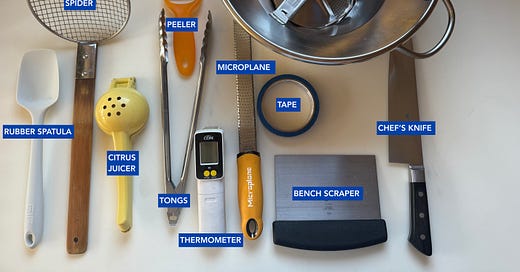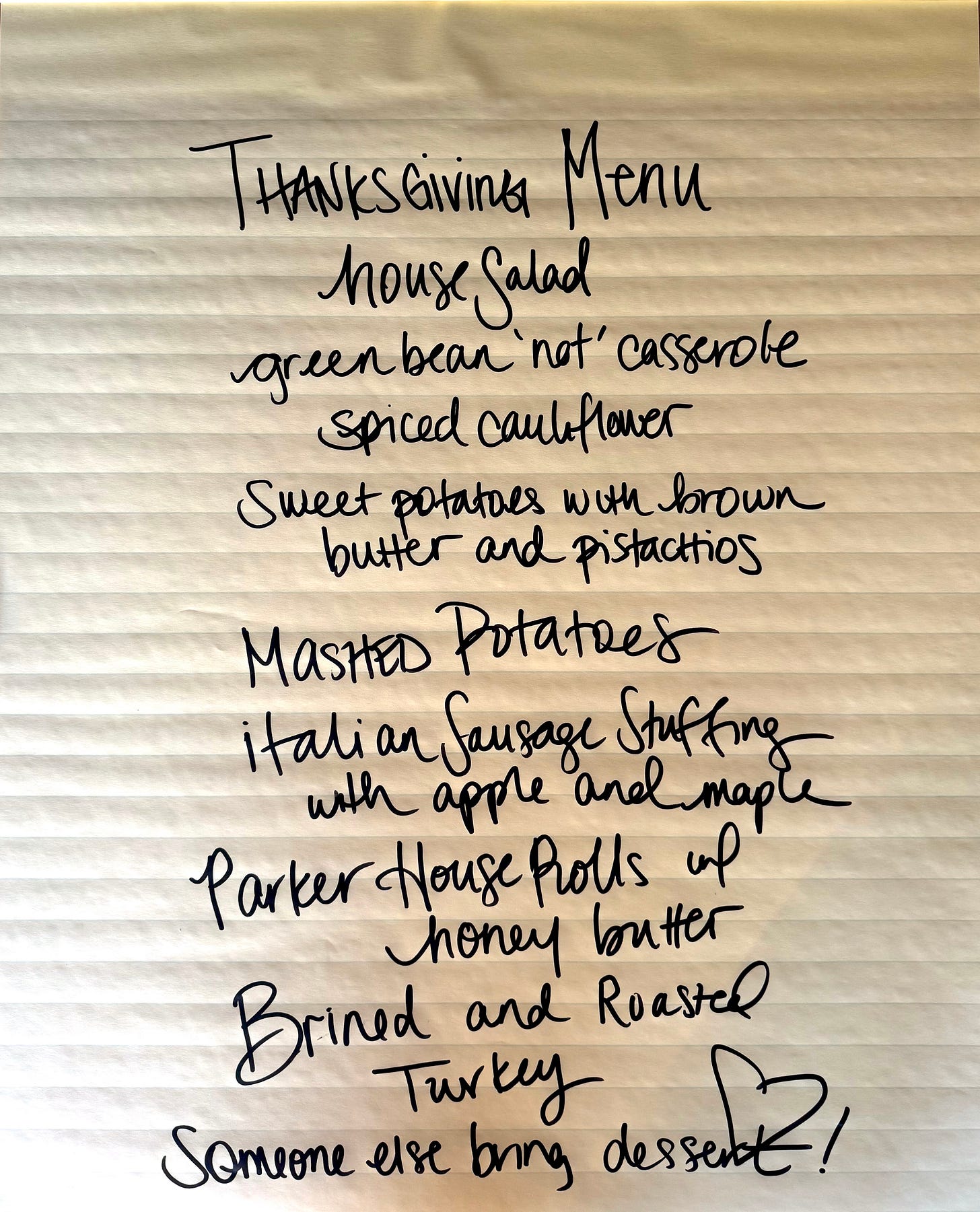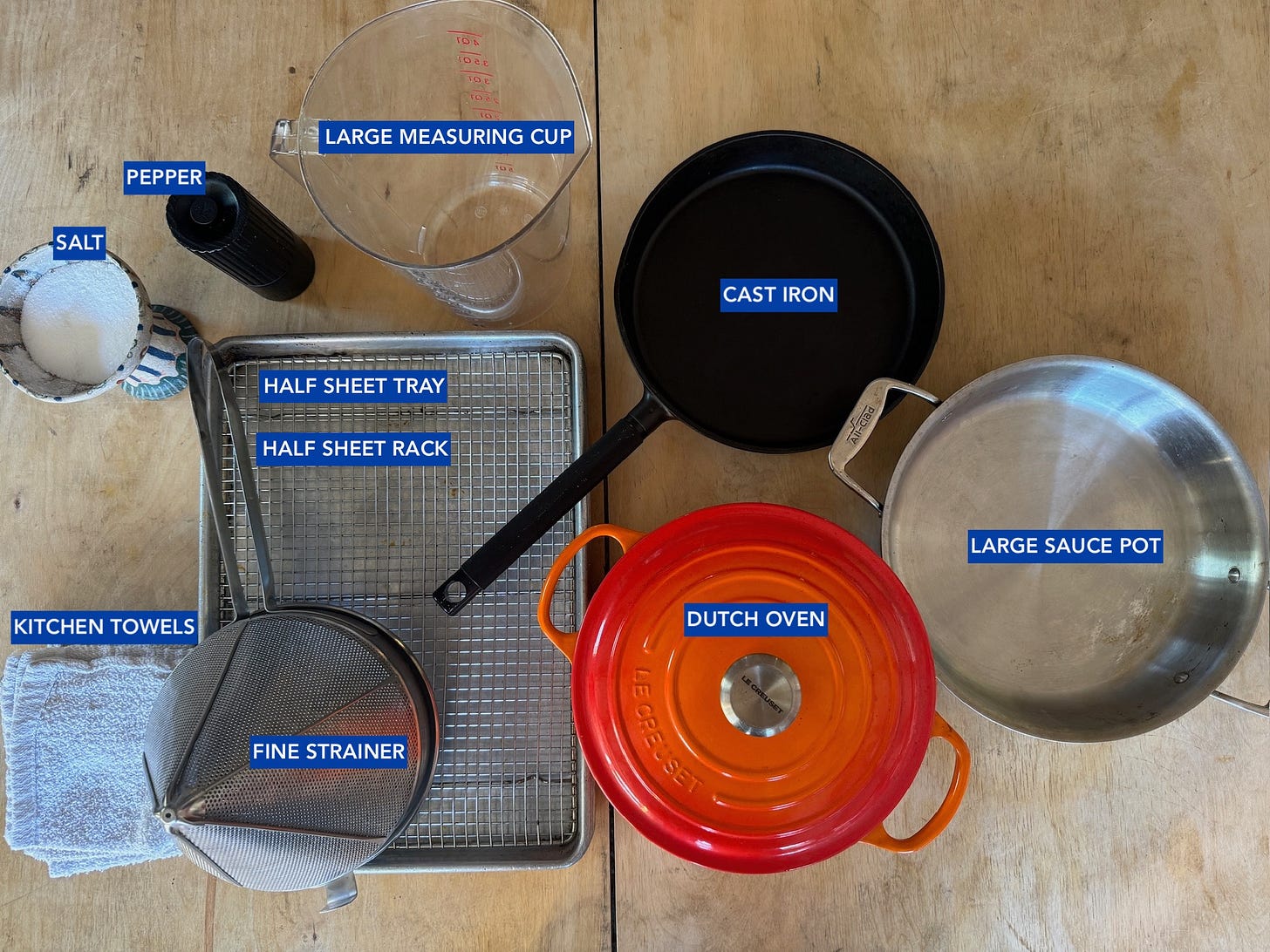Prep is the Key to Success - Thanksgiving Edition
Thanksgiving prep lists! Equipment Lists! Step-by-steps!
Okay, here we go! Put on some tunes and let’s get to work. I know I’m throwing a lot of information your way, so I’m taking another moment to break some things down before we dive head first into a feast of recipes. In catering, private cheffing, and in restaurants, prep tasks are broken out over multiple days. This is essential when executing any dinner or gathering where you plan to do too much for one day. It can be as simple as peeling a bunch of garlic the day before you need it, picking your herbs, measuring your spices and dry ingredients to mise out a recipe.
I’m rolling out the recipes for this ^ menu on Substack as follows:
Thursday 11/14
Brined & Roasted Turkey
Turkey Brine
Herb & Garlic Compound Butter
Gravy
Friday 11/15
Sweet Potatoes with Brown Butter & Pistachios
Mashed Potatoes
Sunday 11/17
Parker House Rolls with Honey Butter
Italian Sausage Stuffing with Apple & Maple
Monday 11/18
Green Bean "Not” Casserole
Spiced Cauliflower
House Salad
Planning your menu is critical so you can properly schedule the prep and lead up to your big event. Let’s start with prep lists and timing. This is a marathon, not a sprint. Until Thursday, then it’s a little bit of a sprint. But you got this. As I’ve mentioned, I’m a big list person. Here’s a list to help guide you starting one week out from the big day. Print it! Make notes!
In case some of the words are new to you, here’s a little index:
Brine - A mixture of water, salt, sugar and spices used to marinate meat, poultry, or vegetables to allow for deeper flavor to build and and retain moisture during cooking.
Deli - Storage containers used to package food, store food, freeze soups and stocks. You can use delis to mise ingredients and meal prep. The three common sizes are 8oz, 12oz, and 32oz.
Flash - Briefly cooking or reheating food at a high temperature.
Mise - Short for mise en place (meaning “everything in its place”) it’s the practice of preparing and organizing all ingredients, tools, and equipment needed for a recipe before beginning to cook. Get your ducks in a row.
Proof - When we allow dough to rest and rise, often in a warm environment, to let the yeast ferment and produce gas before baking.
Pull - Refers to removing food from heat or in some cases removing from refrigeration to temper.
Spatchcock - Removing the backbone and flattening the bird! Spatchcocking allows for quicker, more even cooking and often results in a crisper skin. We like that.
Spider - A tool used to remove items from hot liquid (like pasta from boiling water) or to skim stocks and soups, etc.
Temper - Allowing an ingredient to sit at room temperature. Butter is a common ingredient we like to “temp,” especially in baking. We do this to allow internal temperatures to slowly rise–this is a trick for cooking meat, poultry, and any ingredient you plan to cook or reheat that is held in the fridge, to expedite cook time and ensure even cooking.
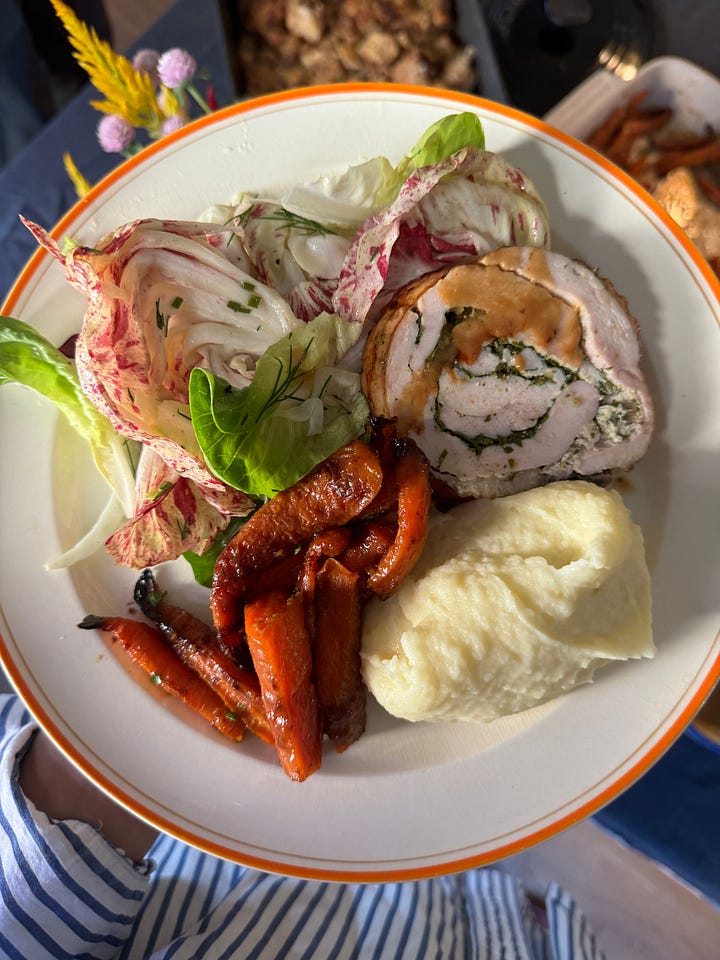
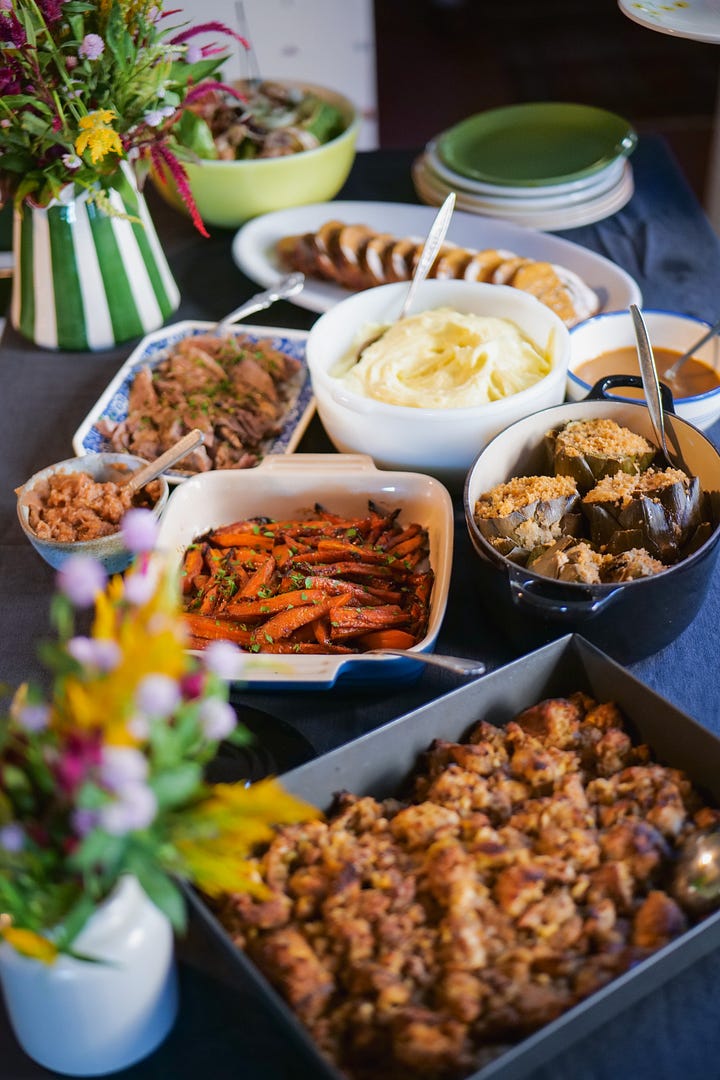

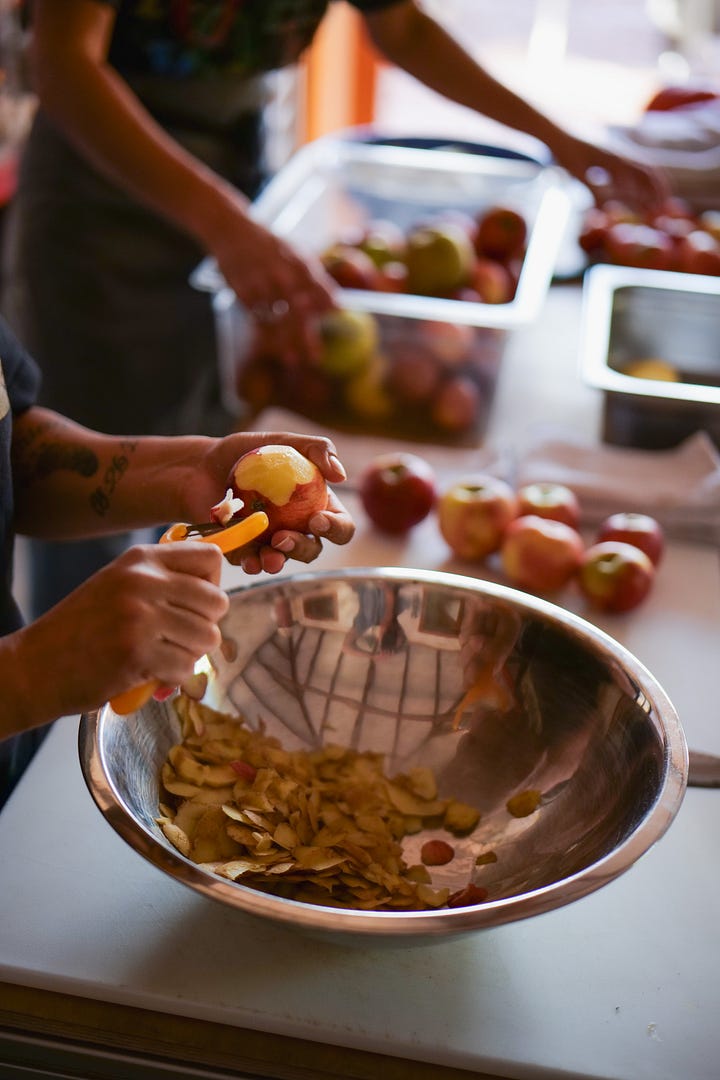
TIPS & TRICKS
EQUIPMENT TIPS
I know most people don’t have a full catering kitchen in their garage but! There are some key things I recommend collecting to build out your kitchen kit. If you don’t have all of the tools pictured, no worries! You can do a lot with a little and can probably make do with what you have. The things I highly recommend buying if you don’t already have:
Cast Iron Skillet
12–18qt Cambro (to brine your Turkey–if you can’t get one, you can use a large stock pot or even a 5 gallon bucket to brine your bird)
Half Sheet Tray & Rack
Fine Mesh Strainer
I will get into how we use all of these tools below in each recipe. The tools you see are all things I use in my kitchen regularly. So often that they’re bumped and bruised and I love that. I always say it builds character–just like people. My kitchen towels aren’t super fancy because they have been through A LOT! You want to have towels accessible that have enough versatility to soak up a spill and also fold up to pull a hot pan out of the oven.
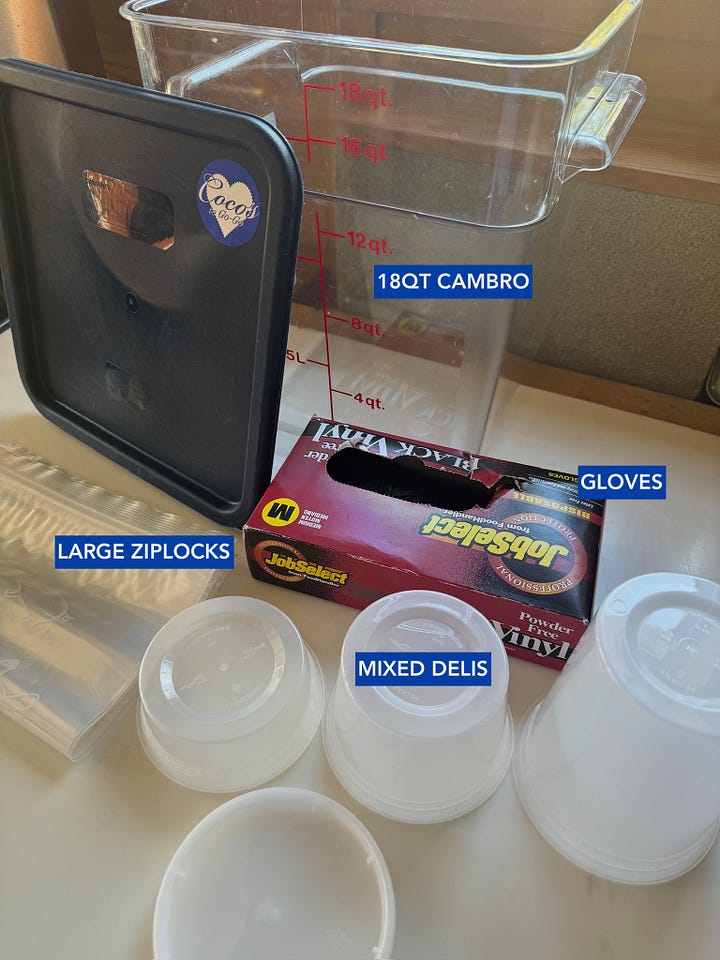
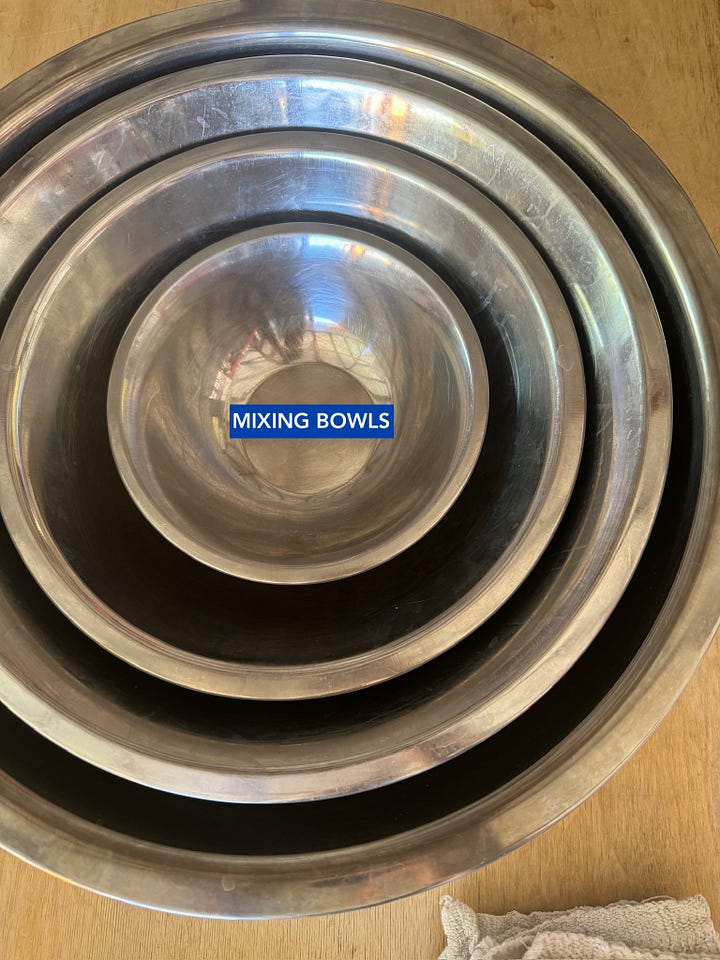
A note on thermometers…the one pictured here is a dual thermometer (a thermocouple). It is an infrared gun and a probe. This is super useful to check your oven temperature (or grill or pizza oven) but also allows you to probe the bird to check internal temp. If you only have access to a good ol’ meat thermometer, that works too.
STORAGE TIPS
How Do I Store My Washed Lettuces and Herbs?
Wash your lettuces and herbs. Dry using a salad spinner or a strainer. Line a large Cambro or Tupperware with clean kitchen towels or paper towels. Layer towels and lettuce, allowing the towel to absorb excess water. This will help your lettuces stay crisp and your herbs stay fresh. You can also line gallon Ziplocks with towels and do the same. Change the paper towel or towel every other day to make sure everything stays nice and crisp until you use.
How Do I Store My Toasted Nuts?
Store your nuts the same way you store your washed lettuce and herbs. Line a deli container or Tupperware with paper towel and store at room temperature. I usually keep them at room temp but they can also be stored in the refrigerator. I snack on them often during the day :).
TURKEY TIPS
Try to secure your turkey early! I like to put one on hold at the farmers market or call ahead to my local grocery store if possible. There’s a wide range of turkeys available***not an ad***but, my personal preference for turkey is Cream Co. Meats—I’ve cooked many different brands, and their quality stands out. If you can find them, it’s worth the price.
For me, choosing a sustainable and responsible purveyor is essential, but I recognize that this isn’t always accessible or affordable for everyone, and that can be incredibly frustrating. It’s vital to find options that align with your budget while still aiming for quality whenever possible. I’ve cooked all kinds of turkeys—frozen and fresh, from Butterball to Cream Co.—and the key is to do what you can within your means. Purchasing all of this food gets very pricey and sometimes even when I go all out - no one even eats the turkey.
How Much Turkey Should I Cook?
It’s helpful to estimate about 1 to 1.5 pounds of turkey per person. For a smaller group or if you’re serving many side dishes, 1 pound per guest should be just right. If you love leftovers, aim for 1.5 pounds per person to ensure there’s enough for everyone, plus some extra for next-day sandwiches or soups. For example, for a gathering of 8 to 10 people, you’ll need a 10 to 15 pound turkey, while a 12 guest dinner might call for a turkey weighing 12 to 18 pounds.
Cooking Times by Weight
For a spatchcocked, unstuffed turkey use the below as an estimated guide:
8 to 12 pounds: 1.5 to 2 hours
12 to 14 pounds: 1.75 to 2.25 hours
14 to 16 pounds: 2 to 2.5 hours
16 to 18 pounds: 2.25 to 2.75 hours
Since a spatchcocked turkey lies flat, it cooks more evenly and faster than a whole bird. Monitor your internal temp so you don’t overcook! Nobody likes a dry turkey. “The rules” say you want the thickest part of your bird to reach 165°F (74°C) internal temperature. That means check the joint between the turkey legs and the breast or you can check the thigh about 1 inch into the turkey. Begin checking the internal temperature about 40 minutes before the suggested cooking time ends. Let the turkey rest for about 30 minutes before carving to allow the juices to stay in the meat, keeping it nice and moist.
SHOPPING TIPS
You’ll be able to make a big shopping list after you finalize your menu and once you receive all the recipes I’m sharing with you this week and next (you’ll have all the tools and recipe you need by Monday 11/18). I suggest doing a big shop the Friday before Thanksgiving for all dry ingredients, dairy and produce. If you have to go the following week make it a limited trip to avoid the crowds. I typically end up running out for fresh herbs, the Turkey, and whatever else I forgot on Friday. Make a list, check it twice.
Get ready, because we’re diving into all things turkey tomorrow. And it’s going to be a big one.
xo
Coco

